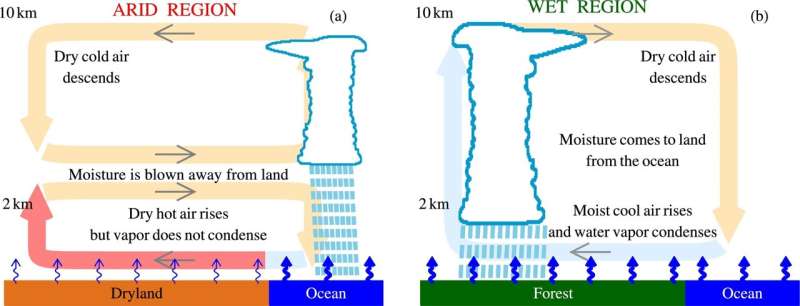
There won’t be many places in the world that have escaped the recent impacts of unusual droughts, floods and unseasonal temperatures. These are often ascribed to the role of greenhouse gases, leading to climate change. But there are additional causes. An international research team has found an additional threat: the impacts of changes in vegetation cover, especially forest loss.
For many parts of the world rainfall depends on what happens to land and water in distant countries. For example, a molecule of moisture that enters Europe from the Atlantic Ocean, may fall as snow or rain and be reevaporated to the atmosphere several times, before it reaches a rainfed field in Central Asia or China.
A new study, recently published in Heliyon, aimed to identify the vulnerability of the atmospheric circulation processes—the drivers of “winds”—that maintain inland rainfall. Temperature and humidity are key and both heavily influenced by a region’s vegetation cover.
Rainfall sustained by suitable vegetation
The key finding is that high temperatures, and lack of suitable vegetation and resulting atmospheric moisture, can block the processes that sustain rainfall over land. In contrast, sufficient moisture being returned to the atmosphere sustains these processes and makes them more resilient.
The research team compared their theoretical predictions against several areas in the Northern Hemisphere, including Western Europe, North America and China. They indicate that current conditions are already close to the threshold where rainfall becomes unstable. The research explains the apparent instability in the systems, leading to droughts and floods.
Large-scale threats require large-scale solutions
The work underlines that forest loss, wetland drainage and other land use changes exacerbates these threats, while conserving and regenerating forests and wetlands reduces them. Furthermore, the results emphasize that these large-scale threats require large-scale solutions that recognize the interconnection that flow across national borders and continents.
The international research led by Dr. Anastassia Makarieva at the Technical University of Munich, Germany, developed the fundamental ideas this research is based upon. The team identified a threshold in terms of temperatures and atmospheric moisture where the processes that maintain the dominant wind patterns cease—something the authors note is already seen in some recent European summers.
Conserve forests and wetlands
Dr. Anastassia Makarieva emphasizes that Russia’s forests have an particularly important role for the Eurasian continent: “The region has been becoming progressively drier, suffering increasingly erratic wind and rain. One important solution is to protect and recover the region’s vast northern forests.”
Professor Douglas Sheil from Wageningen University & Research, a co-author on this study, says he is alarmed by the findings: “Our research shows that we are close to major disruption of the processes that keep much of the world green, pleasant and habitable.”
Douglas notes that while the study is technical, the results and implications are profound.
“The conservationist in me is unsurprised that we have yet more evidence that we disrupt the natural work at our peril,” he says.
“But there is also a positive message: we need nature, and we can defend it and achieve many other benefits at the same time. This study is about the reliable rain that we all depend on. But the solution is to maintain and regain forests and wetlands, that also protect biodiversity, store carbon, and provide many other vital goods and services.”


